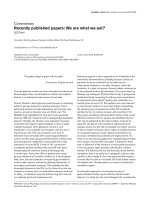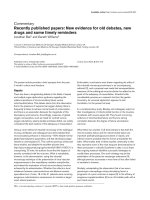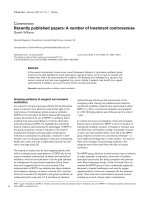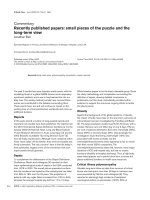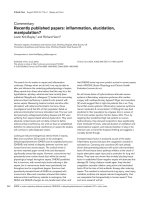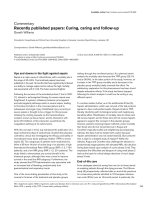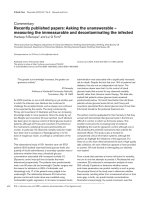Báo cáo khoa học: "Recently published papers: An ancient debate, novel monitors and post ICU outcome in the elderly" potx
Bạn đang xem bản rút gọn của tài liệu. Xem và tải ngay bản đầy đủ của tài liệu tại đây (38.18 KB, 3 trang )
314
CI = cardiac index; CT = computed tomography; Cv–aCO
2
= central venous–arterial carbon dioxide difference; GCS = Glasgow Coma Scale;
HRQOL = health related quality of life; ICU = intensive care unit; Mv–aCO
2
= mixed venous–arterial carbon dioxide difference; PI = pulsatility index;
PT = percutaneous tracheostomy; ST = surgical tracheostomy; TBI = traumatic brain injury; TCD = transcranial Doppler.
Critical Care August 2005 Vol 9 No 4 Sadler and Williams
Abstract
Tracheostomies have been around for close to 3000 years, so one
would hope that the controversies might have been thrashed out
by now, but apparently not. Judging by some recent publications it
would appear that we still do not know when or how to insert them.
Monitoring is fundamental to critical care; two papers describe
novel/modified techniques for assessing traumatic brain injury and
cardiac output. The intensive care unit imposes a heavy treatment
burden, particularly on the elderly. What impact does this have on
the lives of the survivors?
Debate regarding the indications, timing and technique for
tracheostomy seems to have been raging ever since the
procedure itself was first described in ancient Egypt [1]. The
topic is of global interest, with research from a number of
continents published during the past few months. These
recently published papers add new information to the ‘round
table’ discussion that often goes with this controversial and
topical subject.
The first report, that by Griffiths and coworkers [2], is a well
researched systematic review and meta-analysis of five
controlled studies that aimed to compare outcomes in
critically ill patients undergoing artificial ventilation who
received a tracheostomy early or late in their treatment. The
total number of patients involved was 406. Early tracheo-
stomy was defined as up to 7 days following intubation, and
late was defined as any time thereafter, if at all. The results
showed that the duration of artificial ventilation was
significantly lower in the early group, as was the length of
intensive care unit (ICU) stay. This has obvious implications
for ICU service provision and patient care, assuming that
patients leave the ICU to make equal recoveries in the two
groups. However, it is difficult to analyze the impact of the
results because there was significant heterogeneity between
the inclusion and exclusion criteria of the studies. The authors
acknowledge this limitation. The hospital and 30-day mortality
rates were no different between the two groups, and the risk
for hospital-acquired pneumonia was also unchanged.
A recent retrospective study conducted by Chia-Lin Hsu and
coworkers [3] investigated the optimal timing of tracheo-
stomy formation, its impact on weaning from artificial
ventilation, and the outcomes in patients in a medical ICU at
the 1500-bedded National Taiwan University Hospital. A total
of 163 patients were included and divided into two groups:
successful weaning and failure to wean. Interestingly, the
study discusses rates of associated complications of both
percutaneous tracheostomies (PTs) and surgical tracheo-
stomies (STs). The results showed that patients undergoing
tracheostomy more than 3 weeks after intubation had higher
ICU mortality rates (28.3% versus 14.5%), higher rates of
weaning failure (56.4% versus 30.2%) and longer ICU stays
(14.2 days versus 10.8 days). These were all classed as
statistically significant. This study also showed no difference
in hospital mortality or nosocomial pneumonia during the
weaning period. The authors concluded that tracheostomy
after 21 days was associated with prolonged weaning, low
weaning success rates and prolonged ICU stay.
In the third study, Blot and Melot [4] performed a
retrospective analysis of the indications, timing and
techniques of tracheostomy in 152 of the 708 French ICUs
contacted. Although the study had a relatively low reply rate
(21.5%), it raised several interesting points. First, their
definition of early tracheostomy was any time during the first
3 weeks after intubation. Second, early tracheostomy was
considered more often in nonteaching hospitals than in
Commentary
Recently published papers: An ancient debate, novel monitors
and post ICU outcome in the elderly
James Sadler
1
and Gareth Williams
2
1
Specialist Registrar in Anaesthesia, University Hospitals of Leicester, Leicester, UK
2
Consultant in Anaesthesia and Critical Care, University Hospitals of Leicester, Leicester, UK
Corresponding author: Gareth Williams,
Published online: 22 July 2005 Critical Care 2005, 9:314-316 (DOI 10.1186/cc3785)
This article is online at />© 2005 BioMed Central Ltd
315
Available online />teaching hospitals. Finally, STs were preferred over PTs on
surgical ICUs, and vice versa on medical ICUs. The authors
concluded that long-term mechanical ventilation and failed
extubation are the major indications for tracheostomy, and
that tracheostomy is considered after a mean time of 3 weeks
(later than recommended by several consensus conferences).
The final article relating to tracheostomies is that reported by
Raghuraman and coworkers [5]. This prospective and retro-
spective observational study looked into the problem of
tracheal stenosis caused by both PT and ST individually. The
investigators studied 29 patients presenting with tracheal
stenosis to a UK national referral centre for tracheal recon-
struction. Following bronchoscopy preoperatively, they were
able to assess the level, length and diameter of tracheal
stenosis. This potentially life-threatening complication differs
between the two groups in the above parameters, and
therefore affects the treatment options available to the
patient. The results showed that, compared with ST, PT
caused tracheal stenosis closer to the vocal cords (1.6 cm
versus 3.4 cm; P = 0.04) and the onset of tracheal stenosis
occurred significantly quicker in the PT group (5 weeks
versus 28.5 weeks). Other quoted studies [6,7] support the
finding that PT resulted in the tracheal wall ‘caving in’ due to
cartilage fracture significantly more often (50% versus < 2%).
However, the authors demonstrate no difference in diameter
of stenosis. They suggest that good PT technique will
significantly reduce this high complication rate. They also
conclude that stenosis caused by PT occurred earlier and
was more subglottic in nature compared with ST. This higher
level of stenosis was more difficult to correct with surgery.
Considerable variety in the timing of tracheostomy formation
and the technique employed continues to exist, with a
number of other publications both supporting and opposing
the reports discussed above. Intensive care practitioners
clearly need further information and research to enable
agreement to be reached on optimum tracheostomy care.
From these studies, we might be tempted to draw the following
conclusions. First, early tracheostomy (< 7 days) reduces the
duration of artificial ventilation. Second, the length of ICU stay
is reduced by early tracheostomy. Third, patients undergoing
tracheostomy after 3 weeks have a higher mortality, longer
duration of ventilation, reduced successful weaning and longer
ICU stay. Finally, PT causes more subglottic stenosis, with a
quicker onset than with ST. The much anticipated TracMan
study is now underway in the UK and will hopefully shed much
more light on some of these issues.
The vast majority of acute care hospitals in the UK are without
on-site neurosurgical and neurointensive care facilities,
necessitating expedient assessment of the brain-injured
patient. Those with severe traumatic brain injury (TBI; i.e.
those with Glasgow Coma Scale [GCS] score < 9) should
undergo prompt transfer to a neurosurgical centre unless the
prognosis is deemed to be hopeless. For those with mild
(GCS score 14–15) and moderate (GCS score 9–13) TBI,
with no indication for immediate surgery, it may well be
preferable that they stay in the admitting non-neurosurgical
centre, given the demand on the all too few neurosurgical
intensive care beds in the UK. Subsequent monitoring, and
therefore management, of this group of patients for
secondary neurological deterioration is often suboptimal,
given the inability to institute ‘gold standard’ techniques such
as intracranial pressure and jugular venous saturation
monitoring, relying largely on clinical deterioration and
computed tomography (CT). This is likely to have a
deleterious effect on outcome. A study by Jaffres and
coworkers [8] may represent a glimmer of light in this
otherwise dark tunnel.
In a prospective cohort study (n = 78) set in the emergency
room of a French district hospital, consecutive patients
admitted with mild or moderate TBI underwent both CT and
transcranial Doppler (TCD) studies within 12 hours of
admission [8]. Patients were then assessed, based on
objective predefined criteria, for neurological deterioration
7 days after admission. The study attempted to correlate
deterioration with initial measured variables: TCD, CT of the
head, and biochemical, haematological and clinical measures,
including a variety of composite scoring systems. Seven (17%)
patients from the mild TBI group suffered deterioration. Using
univariate analysis the investigators demonstrated a significant
difference in both CT findings and pulsatility index (PI), as
measured using TCD, in this subgroup compared with those
who did not deteriorate. The Injury Severity Score and maximal
Head Abbreviated Injury Scale Score were also significantly
different. In the moderate TBI group, 10 (28%) deteriorated. PI
and CT scoring were again significantly different in this group,
along with the scoring systems mentioned above, initial GCS
score and use of vasoactive drugs.
Jaffres and coworkers [8] go on to discuss the mechanisms
by which PI is inversely related to cerebral perfusion
pressure, and suggest that an appropriate combination of CT
classification of TBI and measurement of PI on admission
may be used to identify those at risk for subsequent
deterioration. However, they point out that the feasibility and
practicalities of early TCD are not inconsequential and that no
threshold value for PI was identified in this small study. This
interesting thesis is surely worthy of investigation in further,
larger studies.
We stay with a monitoring theme in the following report. Less
invasive does not necessarily mean less useful, and Cuschieri
and coworkers [9] – including Dr E Rivers, who utilized
central venous oxygen saturations in early goal-directed
therapy for severe sepsis [10] – investigated the correlation
between central venous–arterial carbon dioxide difference
(Cv–a
CO
2
), mixed venous–arterial carbon dioxide difference
(Mv–a
CO
2
) and cardiac index (CI) in a group of mechanically
316
Critical Care August 2005 Vol 9 No 4 Sadler and Williams
ventilated patients with various diagnoses. For inclusion,
patients needed to have a pulmonary artery catheter in situ.
Simultaneous arterial, mixed venous and central venous blood
samples were obtained, along with measurement of cardiac
indices using the thermodilution technique. The group found
excellent correlation between Cv–a
CO
2
and Mv–aCO
2
, with a
correlation coefficient across all diagnoses and circulation
types (high, low and normal) of 0.978. Furthermore, both
were found to be inversely related to CI, with similar
magnitudes of correlation, as compared with thermodilution-
derived values. This was found to be true across different
flow states. Although the relationship between Mv–a
CO
2
and
CI has long been recognized, as derived from the Fick
principle, this study suggests an easier and less invasive way
to apply the same concept and, in conjunction with centrally
derived arteriovenous oxygen differences, this may be very
useful in the early assessment of global tissue hypoxia.
Finally, a thought-provoking review, although one that is not
terribly helpful on a practical level, was recently published in
Chest [11]. Hennessy and colleagues carried out a thorough
literature search on post-ICU outcomes of elderly patients.
The elderly population, variously defined as > 65 years,
> 70 years, > 75 years or > 85 years, is set to grow massively,
and this will undoubtedly have major implications for service
provision. Although many studies have scrutinized mortality
rates from critical illness in the elderly, little is known about
health-related quality of life (HRQOL) and functional status in
the survivors. The investigators identified only 16 studies
(involving a total of 3247 patients), only one of which was
multicentred, addressing this issue. Encouragingly, the
majority of these studies reported good HRQOL and
functional status post-ICU, although some discordance was
evident, suggesting a change in conceptualization of quality
of life following critical illness. However, the authors were
unable to pool results and draw any significant conclusions
because of poor quality study designs and lack of consensus
on how to measure HRQOL. They urge the need for further
research, which must be well designed, prospective and use
validated, reliable and responsive measures of HRQOL.
Competing interests
The author(s) declare that they have no competing interests.
Reference
1. Chinsky KD: Varying approaches to tracheostomy: “vive la dif-
férence”. Chest 2005, 127:1083-1084.
2. Griffiths J, Barber VS, Morgan L, Young JD: Systematic review
and meta-analysis of studies of the timing of tracheostomy in
adult patients undergoing artificial ventilation. BMJ 2005, 330:
1243-1246.
3. Hsu C-L, Chen K-Y, Chang C-H, Jerng J-S, Yu C-J, Yang P-C:
Timing of tracheostomy as a determinant of weaning success
in critically ill patients: a retrospective study. Crit Care 2005, 9:
R46-R52.
4. Blot F, Melot C: Indications, timing, and tecniques of tra-
cheostomy in152 French ICUs. Chest 2005, 127:1347-1352.
5. Raghuraman G, Rajan S, Marzouk JK, Mullhi D, Smith FG: Is tra-
cheal stenosis caused by percutaneous tracheostomy different
from that by surgical tracheostomy? Chest 2005, 127:879-885.
6. Van Heurn LWE, Theunissen PHMH, Ramsay G: Pathological
changes of the trachea after percutaneous dilatational tra-
cheostomy. Chest 1996, 109:1466-1469.
7. Dollner R, Verch M, Scweiger P: Laryngotracheoscopic findings
in long term follow-up after Griggs tracheostomy. Chest 2002,
122:206-212.
8. Jaffres P, Brun J, Declety P, Bosson J-L, Fauvage B, Schleierma-
cher A, Kaddour A, Anglade D, Jacquot C, Payen J-F: Transcra-
nial Dopplar to detect admission patients at risk for
neurological deterioration following mild and moderate brain
trauma. Intensive Care Med 2005, 31:785-790.
9. Cuschieri J, Rivers E, Donnino M, Katilius M, Jacobsen G, Nguyen
B, Pamukov N, Horst M: Central venous-arterial carbon dioxide
difference as an indicator of cardiac index. Intensive Care Med
2005, 31:818-822.
10. Rivers E, Nguyen B, Havstad S, Ressler J, Muzzin A, Knoblitch B,
Peterson E, Tomlanovitch M: Early goal directed therapy in the
treatment of severe sepsis and septic shock. N Engl J Med
2001, 345:1368-1377.
11. Hennessy D, Juzwishin K, Yergens D, Noseworthy T, Doig C: Out-
comes of elderly survivors of intensive care: a review of the
literature. Chest 2005, 127:1764-1774.

